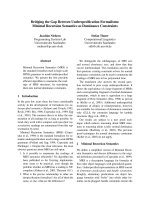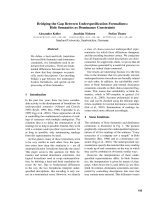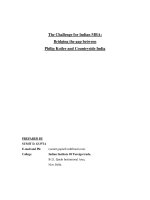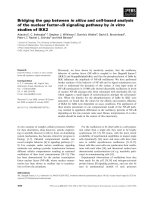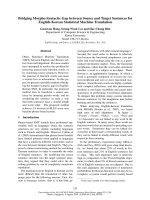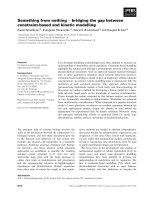Reducing learners language anxiety bridging the gap between research and practice
Bạn đang xem bản rút gọn của tài liệu. Xem và tải ngay bản đầy đủ của tài liệu tại đây (1.05 MB, 23 trang )
Reducing Learners’
Language Anxiety: Bridging
the Gap between Research
and Practice
by Angelica Galante
Brock University
Copyright Galante, Angelica (2010). This work is the intellectual
property of the author. Permission is granted for this material to be
shared for non-commercial, educational purposes, provided that this
copyright statement appears on the reproduced materials and notice is
given that the copying is by permission of the author. To disseminate
otherwise or to republish requires written permission from the author.
AGENDA
Warm-up: Have you ever heard these comments?
Defining language anxiety
What research on language anxiety suggest
Talking about students’ fears: BALLI and FLCAS
Bridging the gap: activities that reduce language anxiety levels
Oral evaluation
Case studies analysis
Conclusion
References
Have you ever
heard these
comments?
Warming-up
“I sweat every time I have to speak English with a native speaker”
“I hate speaking English in front of the class”
“My heart starts beating faster every time my teacher asks me a
question”
“I am ashamed of speaking English because of my accent”
“I always feel that other students are more at ease to speak than
me”
“I get upset that I just cannot verbalize what I’m thinking”
“People might think I’m stupid because I can’t express my
thoughts in English”
Affective variables
Defining language
anxiety
Language anxiety → Situationspecific
Research on language anxiety
Research on language anxiety (Philips,
1999; MacIntyre, 1999; Arnold & Brown,
1999; Dornyei, 2005; Woodrow, 2006) has
repeatedly shown that it has a negative
impact on L2 learners’ performance,
especially during speaking practices.
Talking about
students’ fears
Talking about students’ fears
Beliefs About
Language Learning
Inventory (BALLI)
designed by Elaine K. Horwitz (1987)
used to generate classroom
discussion about the language
learning process
E.g.: Some people have a special
ability for learning foreign
languages.
12345
Foreign Language
Classroom Anxiety
Scale (FLCAS)
designed by Horwitz, Horwitz & Cope (1986)
used to identify students who are
mostly likely to suffer from
language anxiety related to
speaking L2.
E.g.: I tremble when I know that
I'm going to be called on in
language class.
Strongly agree Agree
Neither
agree nor disagree Disagree
Strongly disagree
Activities that
reduce language
anxiety levels
Conversation gambits
“Oh, really?”
“Sorry, I don’t get it.”
“Say that again, please.”
“It’s a beautiful day, eh?”
“By the way, …”
“Actually, …”
“Are you serious?”
“No kidding!”
“You know what I mean?”
helps learners carry on a more ‘natural’ conversation and help
build a sense of community in the classroom by the use of common
communicative vocabulary
Cued response
Activity: Imagine your plans for this weekend. Decide whether
you’re going to do these activities. Add more of your own if you like.
Wake up early:
Have dinner out:
Meet friends:
Watch a movie:
Add more:
“I’m going to wake up early on Saturday”
“I’m not going to have diner out.”
“I’m going to meet my friends”
“I’m going to watch a movie”
“I’m not going to work this weekend…”
helps learners, especially in the early stages of learning, to alleviate
the frustration that occurs when they have to focus both on
meaning and on form
Information Gap
Activity: Find out where the international students come from
and in which countries they lived and traveled in.
Student A
Name
comes
from
Mariette
Belgium
Fahrid
Kofi
Quebec
lived in
Student B
travele
d in
Name
Germany
Mariette
USA
Fahrid
Manitoba
Kofi
comes
from
lived
in
travele
d in
Spain
Morocco
Algeria
Colombi
a
helps learners to build a sense of community. The final product was
built as a team, rather than individual answers
Interviews and surveys
Activity: Find someone who...
a. stayed at home Saturday
b. saw a good film last week
c. went out last night
d. didn’t sleep well last night
e. arrived on time for class today
helps learners have a great deal of practice, which lowers L2
oral anxiety
Improvising dialogues
Activity: In pairs, students receive two lines of a dialogue. They
work together and come up with a possible dialogue. They are
allowed some time to rehearse it before presenting it to the
class.
E.g.: I never thought I’d be in a situation like this!
Who said I liked apples?
helps learners work cooperatively with peers; gives them an
opportunity to rehearse their speech; allows them to get used
to presenting in front of other students; if an element of
comedy is introduced it helps break the ice
Oral evaluation
Helping lower students’ level
of anxiety during oral tests
Provide students’ with ample opportunities for oral practice in class
Use the same types of activities students have practiced in class
Test students’ in pairs or small groups
Role-plays are excellent tools for evaluating communicative
competence
Humorous role-play could be incorporated into the testing situation
Teachers need to re-evaluate the evaluation instrument itself: test
communicative competence and not only accuracy
Students’ test anxiety may be lower if they are aware that their
communicative competence will be rewarded
Case studies
analysis
Case 1: Kim’s a 13 year-old from Korea studying ESL in Canada. She
rarely makes oral contributions in class as she says she prefers to
listen. She once told the teacher that she starts to panic when she has
to speak without any preparation in class.
Case 2: Luis is a 42 year-old from Colombia studying EFL in his
country. He is a successful manager in a multinational company and
wants to be able to speak English fluently with his clients. However,
Luis is very shy and feels “stupid” when he speaks in front of his peers.
Case 3: Sonya is a 35 year-old woman who has recently immigrated to
Canada from Poland. She wants to learn English so she can work as a
nurse. She’s attending a LINC course (level 1) and every time the
teacher asks Sonya to make contributions in the class, she starts
sweating and trembling. She also says she’s afraid of speaking English
with native speakers.
Conclusion
Concluding…
Teachers are encouraged to be aware of students’ anxiety
about language learning to better help them manage their anxiety.
Activities that help learners cooperate and depend on their
peers foster an environment conducive to the development of
community.
Learners feel more at ease and willing to be engaged in oral
activities if there is a more relaxing environment in the class.
Maintaining the development of communicative competence is
a tool to help learners lower their level of anxiety. Provide
students’ with ample opportunities for oral practice in class
Providing the opportunity for learners to face their “fears” is
more important than simply “protecting them from speaking in L2”
References
Arnold, J. & Brown, H. (1999). Introduction: A map of the terrain. In Arnold, J. (Ed.) Affect
in Language Learning (pp. 1-24). New York: Cambridge University Press.
Dornyei, Z. (2005). The Psychology of the Language Learner: Individual Differences in
Second Language Acquisition. Mahwah, N.J.: Lawrence Erlbaum Associates.
Horwitz, E. K., Horwitz, M. B., & Cope, J. (1986). Foreign language classroom anxiety. The
Modern Language Journal, 70(2), 125‐132.
Horwitz, E. K. (1987). Surveying student beliefs about language learning. In A. Wenden &
J. Rubin (Eds.), Learner strategies in language learning (pp. 119–129). Englewood Cliffs,
NY: Prentice Hall
MacIntyre, P. D. (1999). Language anxiety: a review of the research for language
teachers. In Young, D. (Ed.) Affect in Foreign Language and Second Language Learning: A
Practical Guide to Creating a Low Anxiety Classroom Atmosphere (pp. 24-45). Boston:
McGraw- Hill.
Phillips, E.M. (1999). Decreasing Language Anxiety: Practical techniques for oral
activities. In D.J. Young (Ed.), Affect in foreign language and second language learning: A
practical guide to creating a low anxiety classroom atmosphere (pp. 124–143). Boston:
McGraw-Hill.
Woodrow, L. (2006). Anxiety and speaking English as a second language. RELC Journal,


